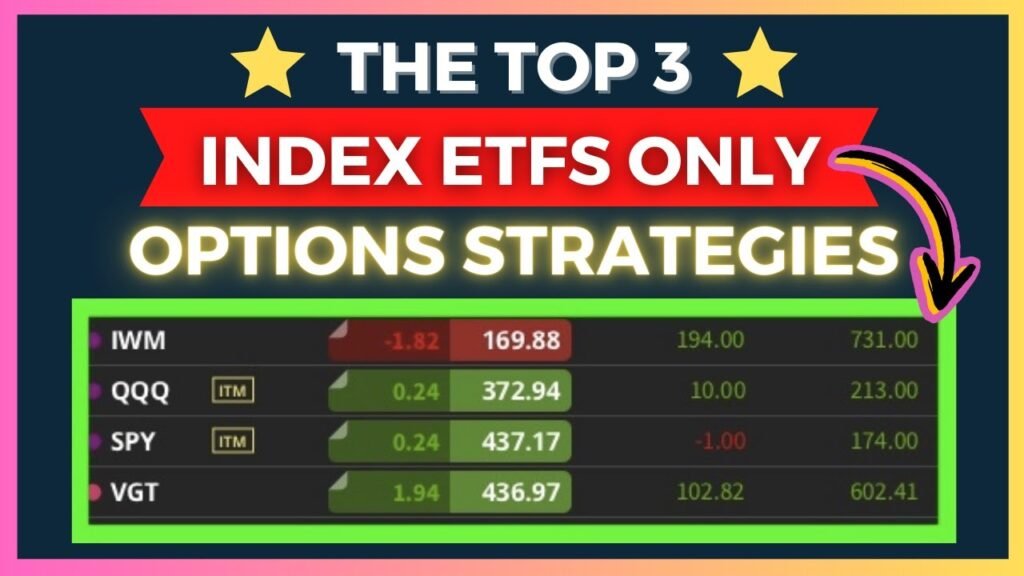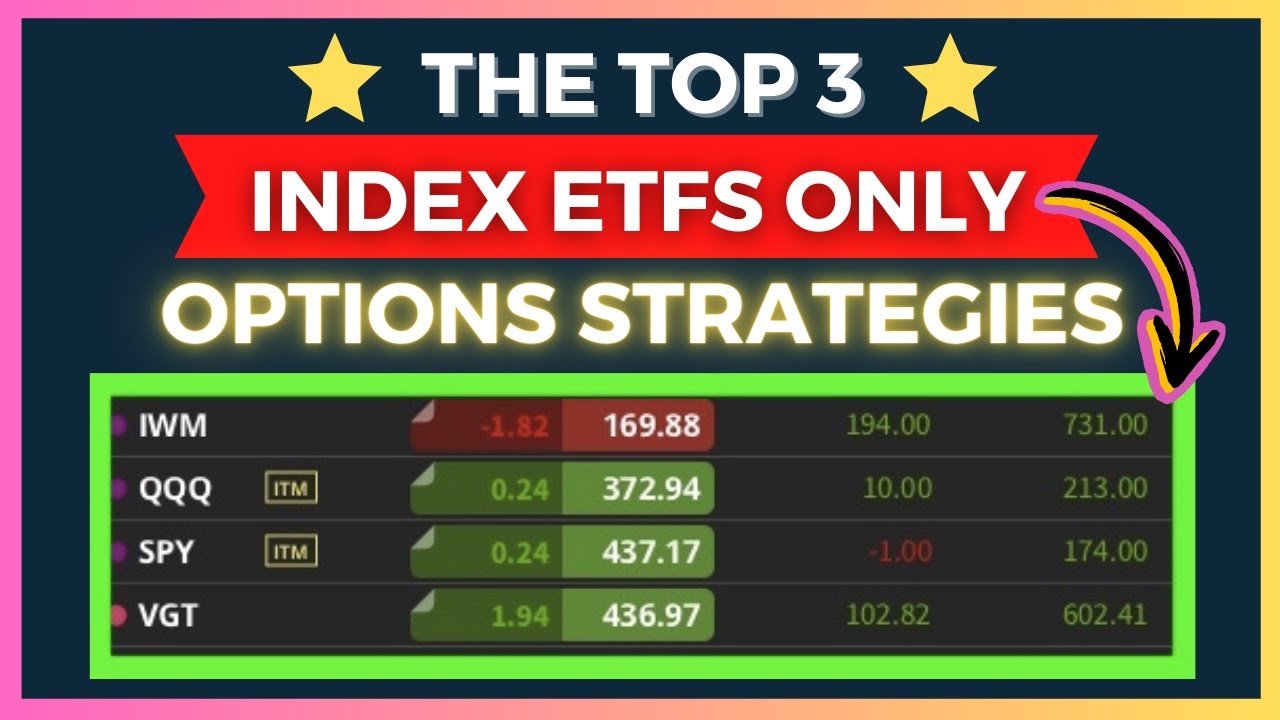In the video titled “ONLY Index ETFs Options Strategies (For Beginners)” by Options with Davis, you’ll find valuable information on options trading strategies for index ETFs. The speaker shares his top 3 strategies for consistent options trading results, which include credit spreads, iron condors, and the Jade iron condor. These strategies are particularly suitable for index ETFs due to their positive drift and the likelihood of the realized move being smaller than the expected move. The video also mentions the availability of a free copy of The Options Income Blueprint. So if you’re a beginner looking to enhance your options trading skills, this video is a must-watch!
Get ready to dive into the world of index ETF options strategies with Options with Davis. In this video, he discusses his top 3 strategies for beginners, including the bull put spread, iron condors, and the Jade iron condor. These strategies offer consistent results and take advantage of the positive drift in index ETFs. Plus, you’ll have the opportunity to get a free copy of The Options Income Blueprint. Don’t miss out, this video is packed with valuable information that can take your options trading to the next level!
Index ETFs Options Strategies (For Beginners)

1. Introduction to Index ETFs Options Trading
1.1 What are Index ETFs?
Index ETFs, or exchange-traded funds, are investment funds that are traded on stock exchanges and are designed to track the performance of a specific index, such as the S&P 500 or the Nasdaq 100. They offer investors the opportunity to gain exposure to a diversified portfolio of stocks with the convenience of buying or selling those shares on an exchange.
1.2 What are Options?
Options are financial derivatives that give investors the right, but not the obligation, to buy or sell an underlying asset at a predetermined price within a specified timeframe. In the case of index ETF options trading, the underlying asset is the index ETF itself.
1.3 Basics of Options Trading
Options trading involves buying and selling options contracts, which can be either call options or put options. A call option gives the holder the right to buy the underlying asset at a specified price, known as the strike price, while a put option gives the holder the right to sell the underlying asset at the strike price.
1.4 Advantages of Trading Index ETF Options
Trading index ETF options offers several advantages for investors. Firstly, it provides a way to leverage the performance of the underlying index without having to invest a large amount of capital. Secondly, options provide flexibility in terms of investment strategies, allowing investors to profit from both rising and falling markets. Finally, options offer limited risk as the most an investor can lose is the premium paid for the options contract.
2. Importance of Trading Only Index ETF Options Strategies
2.1 Why Focus on Index ETFs?
Index ETFs are a popular investment choice for many reasons. They provide diversification across a broad range of stocks within a specific index, reducing individual stock risk. Additionally, index ETFs historically exhibit positive price trends over the long term, making them a suitable choice for options strategies.
2.2 Role of Options Strategies in Consistent Trading Results
Options strategies provide a structured approach to trading that can lead to more consistent results. By following a predetermined strategy, investors can take advantage of market conditions while managing risk effectively.
2.3 Risk Management with Index ETF Options Strategies
Risk management is a crucial aspect of any investment strategy. With index ETF options strategies, investors can mitigate risk by using specific options contracts that limit potential losses while still allowing for potential gains.
2.4 The Options Income Blueprint
The Options Income Blueprint is a free resource that outlines various options strategies for trading index ETFs. It provides step-by-step instructions on implementing these strategies and offers insights into risk management and profit potential.
3. Three Top Index ETF Options Strategies
3.1 Credit Spreads Strategy
A credit spread is an options strategy that involves simultaneously selling and buying options contracts with different strike prices. This strategy aims to generate income by selling options contracts with a higher premium than the ones bought. It is a popular strategy for beginners due to its potential for consistent returns and limited risk.
3.2 Iron Condors Strategy
The iron condor is a neutral options strategy that involves selling both a call spread and a put spread simultaneously. This strategy profits when the price of the underlying index ETF remains within a specific range. It is a popular strategy for generating income in sideways markets.
3.3 Jade Iron Condor Strategy
The jade iron condor is a variation of the iron condor strategy that offers defined risk and further enhances profitability. It combines a credit put spread with a smaller credit call spread to capture profits within the expected move while providing downside protection.
4. Credit Spreads Strategy
4.1 Overview of Credit Spreads
A credit spread is a type of options spread strategy that involves selling a near-the-money option and buying a further out-of-the-money option. This strategy aims to generate income from the premium received by selling the closer option while limiting the potential downside risk.
4.2 How Credit Spreads Work
When implementing a credit spread strategy, the investor receives a net credit, which is the difference between the premium received from selling the option and the premium paid for buying the option. The maximum profit is achieved if the price of the underlying index ETF remains below the strike price of the sold option.
4.3 Implementing Credit Spreads for Index ETFs
To implement a credit spread strategy for index ETFs, investors can select options contracts with strike prices based on their market outlook and risk tolerance. By adjusting the spread width and expiration dates, investors can further customize their risk-reward profile.
5. Iron Condors Strategy
5.1 Understanding Iron Condors
An iron condor is an options strategy that involves selling both a call spread and a put spread simultaneously. This strategy aims to profit from a sideways market where the price of the underlying index ETF remains within a specific range.
5.2 Components of Iron Condor Strategy
The iron condor strategy consists of four options contracts: two sold options and two bought options. The sold call option and sold put option are closer to the current market price, while the bought call option and bought put option serve as protection and are further out-of-the-money.
5.3 Applying Iron Condors to Index ETFs
Index ETFs are well-suited for iron condor strategies due to their tendency to exhibit a positive drift and limited volatility compared to individual stocks. Investors can select index ETFs that have a liquid options market and sufficient price range to implement iron condor strategies effectively.
6. Jade Iron Condor Strategy
6.1 Introduction to Jade Iron Condor
The jade iron condor is a variation of the iron condor strategy that offers defined risk and further customization. It combines a credit put spread and a smaller credit call spread to capture profits within the expected move while providing additional downside protection.
6.2 Structure and Benefits of Jade Iron Condor
The jade iron condor strategy consists of selling a put credit spread below the current market price and selling a smaller call credit spread above the market price. This strategy allows investors to generate income from both sides while maintaining a defined risk profile.
6.3 Using Jade Iron Condor for Index ETFs
The jade iron condor strategy is well-suited for index ETFs due to their positive drift and limited price range. By targeting specific support and resistance levels, investors can identify optimal entry points for jade iron condor trades.
7. Why These Strategies Work Well for Index ETFs
7.1 Positive Drift of Index ETFs
Index ETFs historically exhibit a positive drift, meaning they tend to increase in value over the long term. This upward trend provides a favorable environment for options strategies that aim to profit in bullish or sideways markets.
7.2 Likelihood of Realized Move Being Smaller than Expected Move
Index ETFs typically have lower volatility compared to individual stocks, which means the actual price move often falls within a narrower range than expected. This characteristic benefits options strategies like credit spreads, iron condors, and jade iron condors.
7.3 Other Factors Affecting Benefits of Strategies
Market conditions, implied volatility, and individual stock selection can also impact the effectiveness of index ETF options strategies. It is crucial for investors to stay informed and adapt their strategies accordingly.
8. Entry Points for Index ETF Options Strategies
8.1 Importance of Choosing Entry Points
Selecting the right entry points is crucial for maximizing the effectiveness of index ETF options strategies. Entry points should be based on technical analysis, support areas, or indicators that provide insights into potential price movements.
8.2 Support Areas as Entry Points
Support areas, where prices have historically bounced off a certain level, can serve as potential entry points for options strategies. Investors can analyze price charts and identify key support levels to time their trades effectively.
8.3 Stochastic/RSI Indicators for Entry Points
Technical indicators like stochastic and RSI (Relative Strength Index) can provide valuable insights into overbought or oversold market conditions. By using these indicators alongside support areas, investors can identify favorable entry points for their options strategies.
8.4 Combining Support Areas and Indicators for Entry Points
Combining support areas with technical indicators can enhance the accuracy of entry points for index ETF options strategies. The convergence of multiple signals increases the probability of a successful trade.
9. Studies and Profitability of Index ETF Options Strategies
Several studies have been conducted to assess the profitability of index ETF options strategies. These studies have shown overall positive results, indicating that options strategies such as credit spreads, iron condors, and jade iron condors can be profitable over the long term. However, it is important to note that there can still be losing trades, and risk management should always be a priority.
10. Benefits of Using Jade Iron Condor Strategy
The jade iron condor strategy offers several benefits for index ETF options trading. It provides defined risk, captures profits within the expected move, and offers additional downside protection. By implementing this strategy, investors can potentially achieve consistent returns while managing risk effectively.
In conclusion, trading index ETF options strategies can be a valuable approach for beginners looking to enter the options market. Credit spreads, iron condors, and jade iron condors are popular strategies that offer potential profitability and risk management. By understanding the advantages of trading index ETF options, choosing appropriate entry points, and utilizing proven strategies, investors can enhance their options trading experience and strive for consistent results.
